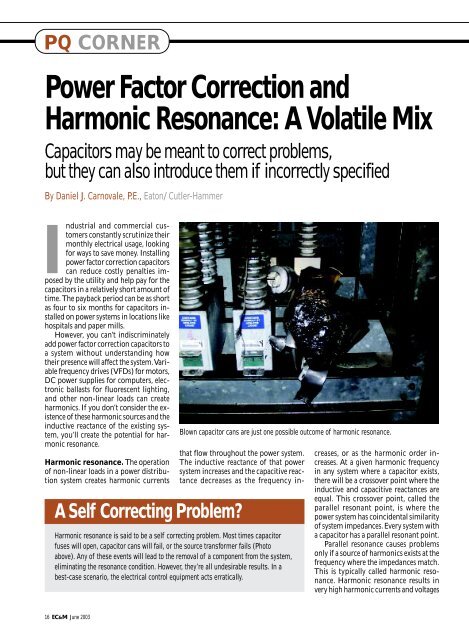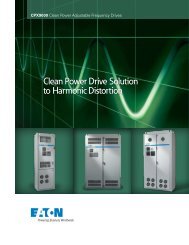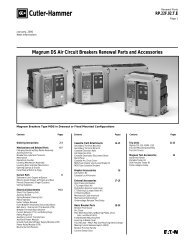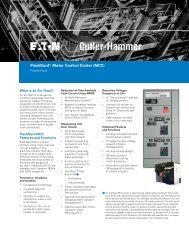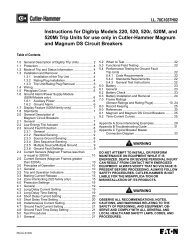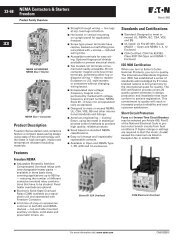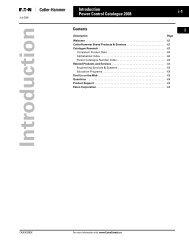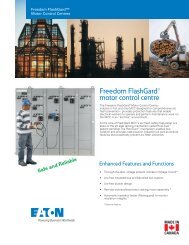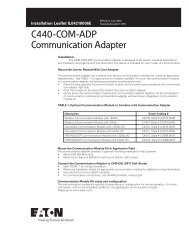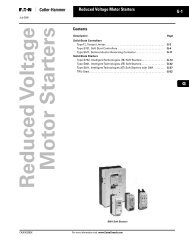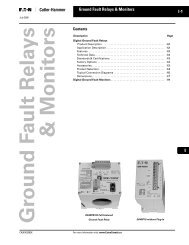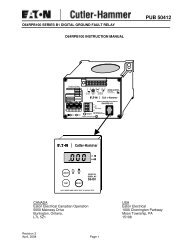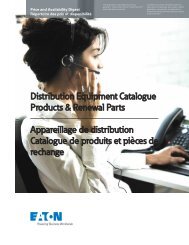Power Factor Correction and Harmonic Resonance: A Volatile Mix
Power Factor Correction and Harmonic Resonance: A Volatile Mix
Power Factor Correction and Harmonic Resonance: A Volatile Mix
Create successful ePaper yourself
Turn your PDF publications into a flip-book with our unique Google optimized e-Paper software.
PQ CORNER<br />
<strong>Power</strong> <strong>Factor</strong> <strong>Correction</strong> <strong>and</strong><br />
<strong>Harmonic</strong> <strong>Resonance</strong>: A <strong>Volatile</strong> <strong>Mix</strong><br />
Capacitors may be meant to correct problems,<br />
but they can also introduce them if incorrectly specified<br />
By Daniel J. Carnovale, P.E., Eaton/Cutler-Hammer<br />
Industrial <strong>and</strong> commercial customers<br />
constantly scrutinize their<br />
monthly electrical usage, looking<br />
for ways to save money. Installing<br />
power factor correction capacitors<br />
can reduce costly penalties imposed<br />
by the utility <strong>and</strong> help pay for the<br />
capacitors in a relatively short amount of<br />
time. The payback period can be as short<br />
as four to six months for capacitors installed<br />
on power systems in locations like<br />
hospitals <strong>and</strong> paper mills.<br />
However, you can’t indiscriminately<br />
add power factor correction capacitors to<br />
a system without underst<strong>and</strong>ing how<br />
their presence will affect the system. Variable<br />
frequency drives (VFDs) for motors,<br />
DC power supplies for computers, electronic<br />
ballasts for fluorescent lighting,<br />
<strong>and</strong> other non-linear loads can create<br />
harmonics. If you don’t consider the existence<br />
of these harmonic sources <strong>and</strong> the<br />
inductive reactance of the existing system,<br />
you’ll create the potential for harmonic<br />
resonance.<br />
<strong>Harmonic</strong> resonance. The operation<br />
of non-linear loads in a power distribution<br />
system creates harmonic currents<br />
16 EC&M June 2003<br />
that flow throughout the power system.<br />
The inductive reactance of that power<br />
system increases <strong>and</strong> the capacitive reactance<br />
decreases as the frequency in-<br />
A Self Correcting Problem?<br />
Blown capacitor cans are just one possible outcome of harmonic resonance.<br />
<strong>Harmonic</strong> resonance is said to be a self correcting problem. Most times capacitor<br />
fuses will open, capacitor cans will fail, or the source transformer fails (Photo<br />
above). Any of these events will lead to the removal of a component from the system,<br />
eliminating the resonance condition. However, they’re all undesirable results. In a<br />
best-case scenario, the electrical control equipment acts erratically.<br />
creases, or as the harmonic order increases.<br />
At a given harmonic frequency<br />
in any system where a capacitor exists,<br />
there will be a crossover point where the<br />
inductive <strong>and</strong> capacitive reactances are<br />
equal. This crossover point, called the<br />
parallel resonant point, is where the<br />
power system has coincidental similarity<br />
of system impedances. Every system with<br />
a capacitor has a parallel resonant point.<br />
Parallel resonance causes problems<br />
only if a source of harmonics exists at the<br />
frequency where the impedances match.<br />
This is typically called harmonic resonance.<br />
<strong>Harmonic</strong> resonance results in<br />
very high harmonic currents <strong>and</strong> voltages
PQ CORNER<br />
at the resonant frequency. It’s extremely<br />
unlikely that these two impedances are<br />
exactly identical, but near resonance can<br />
be very damaging as well. If, for example,<br />
the parallel resonant point is at the 5.3rd<br />
harmonic <strong>and</strong> a source of 5th harmonic<br />
current exists on the system, problems are<br />
likely to occur. In short, harmonic resonance<br />
can result if both of the following<br />
are true:<br />
<strong>Harmonic</strong> loads, such as AC/DC<br />
drive systems, induction heaters, arcing<br />
devices, switch mode power supplies, <strong>and</strong><br />
rectifiers, are operating on the system.<br />
A capacitor or group of capacitors<br />
<strong>and</strong> the source impedance have the same<br />
reactance (impedance) at a frequency<br />
equal to one of the characteristic frequencies<br />
created by the loads. In other words,<br />
the system is parallel resonant at a frequency<br />
equal to one of the harmonics<br />
flowing on the power system.<br />
Generally, harmonic resonance is a<br />
steady-state phenomenon triggered by<br />
an event in which the harmonic source<br />
changes or the source impedance or capacitor<br />
size changes, such as if capacitors<br />
are switched on or off in steps. When installing<br />
power factor correction capacitors,<br />
you can estimate the resulting parallel<br />
resonant frequency, or harmonic order,<br />
by using the following equation:<br />
where h R is the parallel resonant frequency<br />
harmonic order, such as the 5th<br />
or 7th, MVA SC is the source impedance<br />
in MVA at the bus of interest, <strong>and</strong><br />
MVAR CAP is the 3-phase rating in MVA<br />
of the capacitor bank.<br />
For example, consider a source impedance<br />
at a bus of 500MVA <strong>and</strong> a capacitor<br />
bank rating of 10MVA. Plugging these<br />
Measurement Tips<br />
numbers into this equation yields the<br />
following:<br />
So the 10MVA capacitor bank will be<br />
resonant with that source impedance at<br />
the 7th harmonic. If any magnitude of<br />
7th harmonic current flows on the power<br />
system at that bus, the effect could be<br />
catastrophic.<br />
As a practical example, for most<br />
power systems you can estimate the<br />
MVA sc based on the impedance of the<br />
nearest transformer upstream of the capacitor—often<br />
the main service transformer.<br />
For example, a 1,500kVA transformer<br />
with a 5% impedance yields approximately<br />
30 MVA sc (1.5 MVA0.05).<br />
Applying a 250kVAR capacitor results in<br />
resonance near the 11th harmonic.<br />
When you take measurements with a power quality analyzer, one or more of the<br />
harmonic currents will be uncharacteristically high. The characteristic harmonics<br />
normally decrease as frequency increases—the 5th should be higher than the 7th,<br />
the 7th higher than the 11th, <strong>and</strong> so on. <strong>Harmonic</strong> resonance can be evident in the<br />
voltage measurement, but it may not be as obvious or significant.<br />
18 EC&M June 2003<br />
Evaluate every step in your power system to find the potential resonant conditions. Note as the<br />
size of the capacitor bank changes, so does the harmonic order to avoid.<br />
How much can your capacitor<br />
take? IEEE St<strong>and</strong>ard 18-2002, St<strong>and</strong>ard<br />
for Shunt <strong>Power</strong> Capacitors, states that<br />
power capacitors must withst<strong>and</strong> a maximum<br />
continuous rms overvoltage of<br />
110% <strong>and</strong> an overcurrent of 180%, based<br />
on the nameplate rating. This overvoltage<br />
<strong>and</strong> overcurrent includes both the<br />
fundamental frequency <strong>and</strong> any harmonic<br />
contributions. The st<strong>and</strong>ard also<br />
states that the VA rating of the capacitor<br />
can’t exceed 135%.<br />
Engineers typically recommend protecting<br />
a capacitor at 135% of its full load<br />
current. Protection at a higher percentage<br />
will prevent overcurrent protection from<br />
operating during capacitor energizing.<br />
How can you avoid harmonic resonance?<br />
One way to solve the problem is<br />
applying de-tuned harmonic filters or an<br />
appropriately sized capacitor to avoid harmonic<br />
resonance. <strong>Harmonic</strong> filters provide<br />
the same 60-Hz reactive compensation as<br />
capacitors, but they’re typically designed<br />
with a parallel resonance point below any<br />
expected harmonics on the system. Make<br />
sure you consider the existence of harmonic<br />
sources on the power system <strong>and</strong><br />
do a frequency scan <strong>and</strong> harmonic resonance<br />
evaluation to avoid resonance to<br />
guarantee the financial benefits of applying<br />
capacitive compensation.<br />
Special considerations are also very<br />
important for switched power factor
correction banks. You must evaluate every<br />
step (capacitor size) to determine possible<br />
resonant conditions. The Figure at<br />
left shows a six-step capacitor bank versus<br />
harmonic resonant order. The red<br />
lines represent the orders to avoid, including<br />
the 5th, 7th, <strong>and</strong> 11th. If this same<br />
bank were designed as a harmonic filter,<br />
the parallel resonant point at any given<br />
stage would be equal to approximately the<br />
3.5th harmonic—well below the 5th harmonic<br />
current, which is the lowest significant<br />
harmonic on this power system.<br />
Keep in mind the following tips:<br />
Always consider harmonic resonance,<br />
even when applying a small capacitor<br />
on a large system. High harmonic<br />
order resonance, such as the 23rd har-<br />
Always consider<br />
harmonic resonance,<br />
even when applying a<br />
small capacitor on a<br />
large system.<br />
monic, can be especially troublesome<br />
because significant heat <strong>and</strong> interference<br />
can be created even at low magnitudes.<br />
Don’t convert 480V capacitors to<br />
480V filters because continuous overvoltage<br />
may damage the capacitors.<br />
Make sure you account for actual<br />
kVAR when applying higher rated capacitors<br />
on a lower rated system. Applying<br />
600V capacitors on a 480V system, for<br />
example, yields 64% of rated kVAR.<br />
If you keep blowing fuses or tripping<br />
a breaker on a capacitor bank, measure<br />
the capacitor current <strong>and</strong> look for<br />
high harmonic currents.<br />
Everyone’s looking for ways to save<br />
money, <strong>and</strong> eliminating power factor<br />
penalty charges is one place to start. However,<br />
you must consider several factors before<br />
investing in capacitors—you may create<br />
conditions that result in misoperation<br />
or damage to equipment. The number of<br />
non-linear loads on your system will dictate<br />
what route to take. EC&M<br />
Carnovale is the power quality solution<br />
manager with Eaton/Cutler-Hammer in<br />
Pittsburgh.<br />
Circle 10 on Reader Service Card or<br />
visit freeproductinfo.net/ecm<br />
June 2003 EC&M 19


